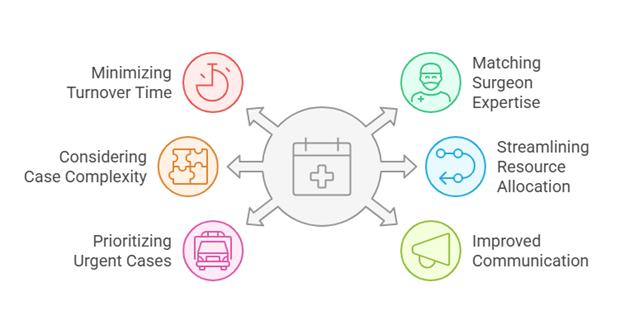In the high-stakes environment of surgical care, the operating room (OR) stands as one of the most resource-intensive and complex spaces in a hospital. Every minute in the OR carries substantial weight financially and clinically. That’s why surgical scheduling is no longer just a clerical task. It plays a direct role in optimizing resource use, reducing idle time and improving communication across teams.
Modern scheduling practices like smart tools and historical data, have transformed what used to be reactive coordination into a proactive, data-informed strategy. In fact, research shows that traditional scheduling methods based on average case duration are accurate only about 13% to 25% of the time — a gap that shows how essential smarter scheduling really is.
Let’s explore the specific ways surgical scheduling improves OR efficiency and contributes to more predictable, productive surgical days.
Impact of Surgical Scheduling on OR Efficiency
The way surgeries are scheduled affects how cases progress, how staff operate, and how consistently the OR stays on track.

Minimizing Turnover Time
One of the main contributors to OR downtime is the turnover period, the time between two surgeries. When surgical schedules are planned to group similar procedures back-to-back, staff can reset the room more quickly due to fewer changes in equipment, sterilization protocols, or room setup. This approach creates a rhythm that leads to faster room turnover without compromising safety or standards.
Some hospitals even use predictive scheduling tools to suggest optimal case sequences. These tools rely on historical data and patterns, reducing unnecessary delays between cases and helping the day move at a steady pace.
Matching Surgeon Expertise
Aligning surgeons with procedures that fall within their area of expertise streamlines surgical time and outcomes. Surgeons operating within their primary specialties typically work more efficiently and confidently, which contributes to shorter procedures and fewer intraoperative complications.
A scheduling system that accounts for surgeon specialty, along with their availability and case history, can prevent mismatches that lead to extended OR time or higher post-op risks.
Considering Case Complexity
Not all surgeries take the same amount of time or resources. An effective scheduling strategy accounts for case complexity and creates a balanced OR day. For example, stacking several long, intricate procedures one after another can result in overruns that delay all subsequent cases. On the other hand, mixing longer surgeries with shorter, lower-complexity ones helps maintain equilibrium throughout the day.
Smart scheduling platforms can analyze case duration patterns and suggest optimal placements to reduce the risk of cascading delays.
Streamlining Resource Allocation
Each surgical procedure requires a specific set of instruments, staff roles, and supporting technology. Scheduling without confirming the availability of these resources leads to bottlenecks and costly rescheduling. OR scheduling tools that provide real-time dashboards for equipment, nursing staff, and anesthesia support can help sync up availability before the day even begins.
This proactive coordination allows schedulers to avoid double-booking high-demand resources, such as surgical robots or specialized teams and improves room readiness. It’s a straightforward way to eliminate common disruptions and get more done with fewer interruptions.
Prioritizing Urgent Cases
OR schedules must remain flexible enough to accommodate urgent and emergency procedures. Whether it’s trauma surgery or an unplanned complication, systems should have designated time blocks or workflows to handle these situations without disturbing the entire day.
Scheduling platforms that integrate clinical alerts and escalation protocols make it easier to assign OR time to urgent cases while still maintaining transparency for the rest of the day’s schedule. When handled well, these adjustments don’t throw everything off — they become part of a system built to adapt.
Improved Communication
Lack of communication between surgical teams is one of the top reasons for intra-day delays. A centralized surgical scheduling system enables alignment across roles from the surgical team to the cleaning crew. Features like real-time dashboards, shared access to updated case notes, and status indicators help all staff stay informed and on time.
At one academic pediatric hospital, process changes like pre-op huddles and streamlined admissions improved on-time starts from 6% to nearly 60% over nine months. That kind of improvement often starts with better communication tied directly to the surgical schedule.
Key Aspects of Effective Surgical Scheduling
Surgical scheduling isn’t just about fitting procedures into available time slots. It’s a strategy built around patterns, predictability, and flexibility. When done well, it supports better OR utilization and improves patient flow across departments.
Block Time Allocation
Block scheduling is a common technique that allocates dedicated OR time slots to individual surgeons or surgical teams based on case volume, specialty, and historical utilization. This method allows providers to plan their caseloads in advance and improves scheduling predictability.
But block allocation works best when supported by transparent utilization data. If blocks are consistently underused, that unused time can be released or reassigned. Some hospitals use dynamic block management systems that track usage trends and automatically suggest reallocation, helping boost OR efficiency without compromising access.
Case Mix Management
Balancing the types of surgeries scheduled in a day or week is essential. A schedule overloaded with high-complexity procedures may lead to bottlenecks, whereas too many short cases in a row might result in idle time if gaps emerge.
A well-balanced case mix considers:
- Surgery duration
- Staffing requirements
- Equipment availability
- Patient recovery needs
Effective scheduling tools can suggest ideal case mixes based on historical patterns and real-time constraints. This reduces the risk of schedule overruns and keeps teams from being overextended.
Flexibility
Even the best-laid schedules can be disrupted by late patient arrivals, equipment failures, or clinical emergencies. That’s why a flexible scheduling model is critical.
Flexibility may involve:
- Reserved open time blocks for emergencies or add-ons
- Clear escalation protocols for urgent cases
- Contingency planning for staff absences or resource conflicts
Implementing Effective Surgical Scheduling
Knowing what makes a schedule effective is only part of the equation, the real value comes from putting those principles into practice. This involves the right mix of technology, training, and performance tracking.
Integrate Advanced Scheduling Software
Modern scheduling tools go far beyond spreadsheets and manual coordination. They provide real-time visibility into OR availability, integrate with EHR systems, and offer predictive capabilities based on past case data.
These platforms allow for:
- Automated conflict detection (e.g., double-booked resources)
- Real-time updates for case delays or cancellations
- Integration with staffing systems to align personnel and procedure schedules
Hospitals using predictive analytics in scheduling have been able to reduce same-day cancellations and improve overall throughput by using data to anticipate when delays or overages are likely.
Train Staff and Standardize Protocols
Introducing a scheduling system requires a coordinated rollout. Staff training is essential, not just for the scheduling team but for all departments that interact with the OR schedule, surgical teams, anesthesia, nursing, central sterile processing, and post-op care.
Key OR Schedule best practices include:
- Clear roles and responsibilities for each step of the scheduling process
- Standardized checklists for pre-op readiness
- Briefings or daily huddles to align expectations and address potential issues early
When everyone knows the schedule, the plan, and their role in it, there’s less confusion and more focus on timely execution.
Monitor Performance Using KPIs
To make scheduling a continuous improvement effort, it must be measurable. Hospitals should define key performance indicators (KPIs) that reflect both efficiency and quality of care.
Common KPIs include:
- First case on-time start percentage
- Average turnover time
- Block utilization rates
- Cancellation rates
- Same-day add-on volume
For example, tracking on-time starts helps reveal where delays occur, whether due to late pre-op prep, incomplete paperwork, or staff readiness. These insights feed directly into policy updates or workflow changes.
Conclusion
Surgical scheduling software affects how efficiently the operating room functions. When planned and managed effectively, it reduces downtime, improves coordination across teams, and helps hospitals use their resources effectively.
By incorporating data, aligning staff, and using scheduling systems that adapt to real-world conditions, healthcare professionals can improve cash flow and reduce avoidable delays. Tracking performance indicators such as block utilization, turnover time, and on-time starts helps identify areas that need adjustment and supports long-term process improvement. Clear planning of OR best practices and consistent execution are key to making surgical schedules work better — for providers, staff, and patients alike.


